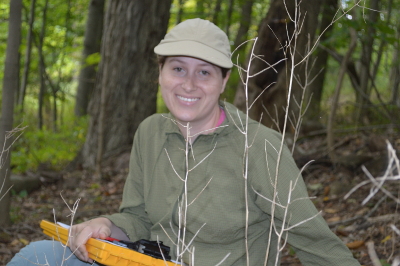NIMBioS Postdoctoral Fellow Profile: Lauren Smith-Ramesh
Q&A with Dr. Smith-Ramesh
 Hometown: Indianapolis, IN
Hometown: Indianapolis, IN
Field of Study: Community Ecology
What is your field and why does it inspire you? Why did you choose this field?
I am a community ecologist, which essentially means that I study interactions amongst species from microbes to plants to predators. I chose this field because I am inspired by the inherent complexity of ecological systems and the often counter-intuitive phenomena that emerge from this complexity. For example, I found that an invasive plant that we would normally expect to really dominate native plant species actually undermines its own dominance by providing habitat to a spider predator that indirectly benefits native plants. This view of the species only emerges in the context of a complex food web.
Describe your current research.
Exotic invasive species, which are organisms introduced to a new environment where they become dominant and often cause ecological harm, must contend with a whole food web full of potential competitors and predators when they are introduced to a new region. However, we often only study these species within small subsets of food webs, such as when we study competition amongst different plant species. I am interested in placing invasion in a broader food web context in order to determine how food web structure influences the ability of certain species to become successful invaders, as well as the susceptibility of certain habitats to invasion.
What is the biggest obstacle to achieving your objective(s)?
The complexity that inspires my interest in ecology is also the greatest obstacle! It is rarely possible to find all of the data that you would need to fully understand a complex food web or to generate theory that balances complexity with the need for models to be simple enough to be useful.
How does your work benefit society?
Invasive species can be a significant threat to biodiversity and also require a lot of resources to manage. My work helps conservationists to decide which invasive species matter the most, which habitats are the most sensitive to invasion, and how we can best allocate our management resources.
What do you like best about your work?
In the field, I love observing ecological interactions and thinking about how their implications might ripple throughout a complex food web. At NIMBioS, I enjoy the challenge of developing theory that can explain interesting ecological phenomena while still being simple enough to be described as "elegant."
Which professional accomplishment are you most proud of?
Surprisingly, one of my most important professional accomplishments stems from a natural history observation I made by accident. During my first year of graduate school, I set out to collect seed from an invasive plant called garlic mustard from across the entire state of Indiana. I collected garlic mustard seed by shaking mature fruits into a bucket and noticed something odd. Every time I shook seed into my bucket, I got a small handful of spiders as well! It turns out that several families of web-building spiders preferentially use garlic mustard's fruit structure as a "website." This led me to a new perspective about the way plants interact with food webs, which has spurred my research in new and exciting directions. I find this type of story to be common amongst scientists I talk to: often our most exciting discoveries come about in serendipitous and often unintended ways.
On the other hand, what has been your most discouraging professional moment and how did you recover? What did you learn?
Dealing with rejection is never easy, but as academic ecologists we deal with constant rejection, whether of grant proposals, papers, or job applications. One of the most discouraging moments was when a paper from my dissertation that I had really poured my heart and soul into was rejected after two rounds of review. This was particularly tough because I really thought that I had addressed the reviewers' concerns. I recovered by listening to a very comforting "rejection playlist" I put together (it's mostly Jakob Dylan songs) and then revising and re-submitting to an even better journal. While it might sound cliché, I learned from this and my many other rejections that this process generally results in better papers and better science, so these moments of pain are worth it in the end.
What is the most surprising aspect of your work?
In a field experiment where I studied the interactions between an invasive plant and spiders that build their webs on its fruit, I found that tiny cobweb spiders can locally increase the nutrients available to plants in the soil, most likely by dropping insect carcasses below their webs. This often surprises people, but based on the number of insect carcasses accumulating under a spider web in the corner of my office, I can see how spiders would have a big impact on soils!
What exciting developments lie in the future for your field?
The fundamental questions in my field are 1) why do certain species become invasive? and 2) why do certain habitats become invaded? The field of invasion ecology is still fairly young, but I think we are getting a lot closer to understanding some fundamental answers to these questions. For my part, I hope to ascertain the way that food web interactions influence invasibility and invader impact.
What do you do when you're not in the lab or out in the field?
I enjoy being outdoors, spending time with my family, cooking vegetarian food, and going to concerts and musicals. When I get the chance to travel, I love to SCUBA dive, snorkel, and generally just spend as much time near the ocean as possible.
Lauren Smith-Ramesh's Postdoc page
NIMBioS
1122 Volunteer Blvd., Suite 106
University of Tennessee
Knoxville,
TN 37996-3410
PH: (865) 974-9334
FAX: (865) 974-9461
Contact NIMBioS




